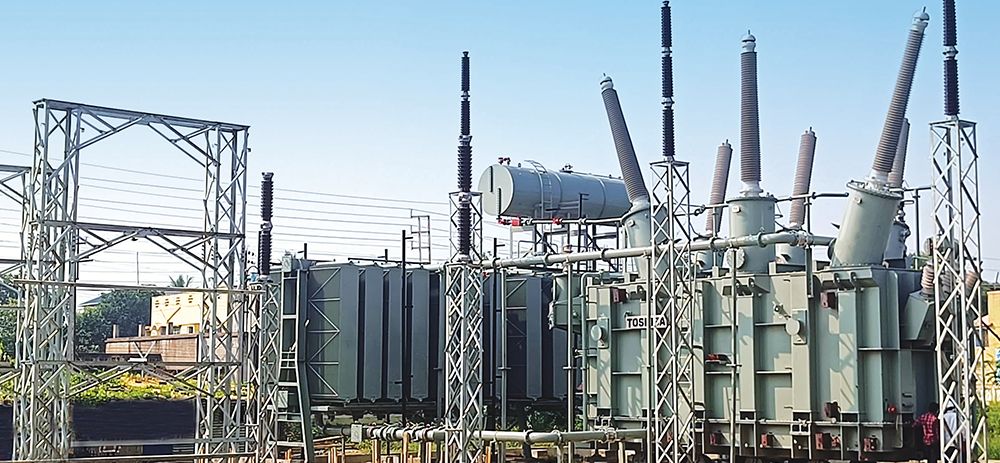Rewards for keeping EHS top priority
WBSETCL – Package C2 Project

Project Manager, Rana Datta, of PT&D’s WBSETCL Package C2 Project that he is executing across three districts of West Bengal in extremely difficult conditions, is a proud leader having won the International Safety Award, the Silver 3-Star Award from the World Safety Organization and a RoSPA Silver, all in 2024. “These awards are due recognition for our unwavering focus on EHS, ensuring that everyone at site, right from me to the last worker, is aligned to our safety protocols,” shares a delighted Rana. However, both he and his EHS Manager, Saumya Kanti Ghosh, are acutely aware that having set high standards, they need to sustain them as their project progresses.

These awards are due recognition for our unwavering focus on EHS, ensuring that everyone at site, right from me to the last worker, is aligned to our safety protocols.
Rana Datta
Project Manager


The WBSETCL Package C2 is for all practical purposes three projects rolled into one, involving the construction of a 220/33 kV GIS at Mangalpur, upgrading a 220/132/33 kV substation to a 400 kV GIS along with erecting 400 kV D/C transmission lines at Satgachia, and constructing a 132/33 kV substation associated with 132 kV transmission lines at Raghunathganj. “Our scope of main operations at site includes the installation of transmission towers, 400 kV & 132 kV transmission lines, construction of 400 kV GIS, 220/33 kV GIS and two 132 kV line bays,” shares Rana.
Overcoming situational, engineering & construction challenges
All this work comes with its fair share of challenges, one of the earliest being to transport and unload two 500 MVA transformers & reactors, each weighing approximately 250 MT. “We have had to negotiate a railway over bridge near Dehri, on the River Sone, of Durgapur Steel that is a large metal structure with pipes, a railway crossing at Rasulpur on the Howrah–Delhi mainline, a 4-way turning at Satgachia Chawk and of course, overhead LT/HT lines,” explains Planning Engineer, Sahukari Kaushik. “The soil throughout our alignment has poor load-bearing capacity,” he sighs.

We have had to negotiate a railway over bridge near Dehri, on the River Sone, of Durgapur Steel that is a large metal structure with pipes, a railway crossing at Rasulpur on the Howrah-Delhi mainline, a 4-way turning at Satgachia Chawk and of course, overhead LT/HT lines.
Sahukari Kaushik
Planning Engineer


Apart from the situational challenges, the team has some engineering challenges too like constructing the 400 kV GIS building with 15+ m slab height on the first floor. “It is a unique design for which we used seven 1,250 × 500 mm dipper beams that are 17 m long with a 4-leg stirrup arrangement, having each ring inserted to overlap with the next,” Rana explains the complexity. “There are thirty 1,200 × 500 mm columns with the Corbel Beam height at EL +10.15 m.”
Despite the complex design, Rana and Saumya are proud that they clocked 1,17,180 LTI-free manhours casting the slab of this 400 kV GIS building.

Foundation piling for the three 78 m tall multi-circuit towers, each having 32 piles of 1,200 mm dia and a depth of 30 m, all on agricultural land, was their next challenge. “We have had to prepare a temporary road with adequate strength to move our equipment like transit mixers, piling rigs and cranes,” informs Sahukari.

The 400 kV towers are approximately 50–60 m in height and the team’s main issue was to move the tower material through agricultural land. “Being a wellhabited area, unauthorized access of the villagers into our areas of operation was a headache,” says Saumya, tapping his head, “for which we had to completely barricade the area.” As the underfoot conditions are slushy, they need to be extra careful to properly ground the guy support crowbars, which are periodically checked. “Since we were erecting the towers adjacent to an LT line, we took shutdowns from the client following all the shutdown procedures,” he adds.

Ensuring that all other EHS fronts are covered
Line surveys and preparation PTP for shutdown works is done 72 hours prior to work execution and 24 hours prior for non-shutdown works, which are then uploaded to SHEILD by the Site Engineer to be approved by the Section In-charge and EHS In-charge. The team has developed Emergency Shutdown and Non-shutdown Pre-Task Plans, anticipating client requests to urgently complete critical tasks.
Saumya mentions that height pass tokens are given to those working at heights only after they undergo the vertigo test & a medical check-up including ECG. Apart from establishing a Safety Park and a Safety Induction Room at site, they have implemented a colour-coded safety induction tag system that is inspected every month and changed to green if the work is done and red if found not safe for use. All edges & staircases are adequately protected.

Training programmes are available on HIRA, SOPs of work activities, behaviourbased safety, defensive driving, e-learning, VR, traffic management and more as per the training calendar after identifying training needs of individuals. The team has conducted HIRA for every work activity. A Daily Work Plan (DWP) is strictly implemented for all activities.

Our Package C2 Project has been consistently ranked Number 1 among all SS BU projects in the monthly performance ranking system over the last 12 months (September 2023 to August 2024).
Saumya Kanti Ghosh
EHS Manager


“For us, a stringent EHS management system is critical considering that currently we have employed 270 employees and workmen, including subcontractor employees, with multiple activities happening at our site which is spread out over existing running substations and transmission lines,” remarks Rana. Saumya attributes their best safety procedures and systems for the team having thus far successfully completed all their critical activities with flying colours. “Our Package C2 Project has been consistently ranked Number 1 among all SS BU projects in the monthly performance ranking system over the last 12 months (September 2023 to August 2024),” he concludes with a thumbs up.